My last post incited several technical questions, mainly from my mom. Her first question was, how do we get water on the boat? This is how….
Plumbing
Livable boats come equipped with plumbing. At a minimum, for fresh drinking water. In our boat, the plumbing services the kitchen sink, the sinks/showers in the toilets and an outside shower that we use to wash off salty water after swimming in the sea. Our toilets do not use the plumbing system as they function with water from external sources (port water or the sea, depending on where the boat is).
Boats are furnished with large bins to store fresh water. Our boat has 4 bins, 2 of 150 liters and 2 of 300 liters, so we have a total capacity of 900 liters. The plumbing is a pressurized system. The pressure pushes the water through the pipes. We know when a bin empties because water from the spout starts spitting out. The system is set up so that when water runs out of one bin, it is automatically sourced from another.
On our boat, we have access to the pressurized plumbing system via a trap door that’s located behind the main sofa cushion.
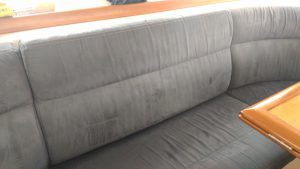
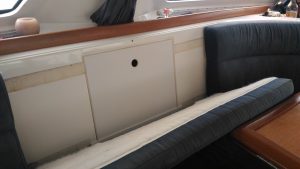
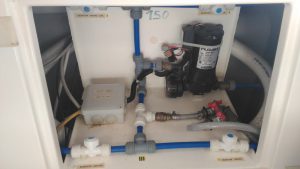
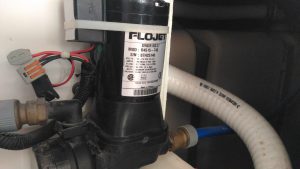
From here we can see the bins that are behind the plumbing system.
This means we occasionally need to fill the bins with fresh drinking water. When it’s just the two of use, our 900 liters can last 2 weeks. If we have guests we’ll need to load up sooner, mostly due to showers.
About showers:
- I have become a pro at the 3-minute shower. Water and lather soap. Turn water off. Clean body and hair. Rinse with water.
- Even if we have showers on the boat, we still occasionally take our showers in the facilities made available by the port. Those showers are very clean, the cost is included in our port fees, and it allows us to use up less of our boat water. 🙂
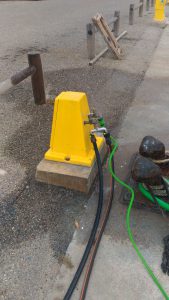
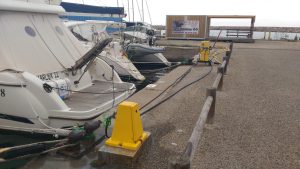
Access to electrical outlets, fresh water and bathroom facilities are usually included in port fees. The water hydrant that services our boat is a wee bit far, as you can tell from the photos above. We have a 30 meter long hose to be able to reach our boat. In any case, a long hose is a good idea as you never know how a port you are visiting will be set up.
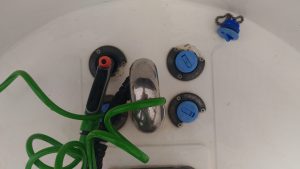
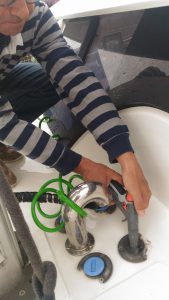
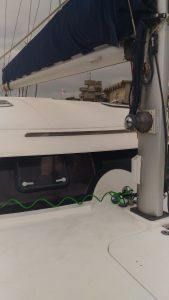
The drains to the bins are located on the deck of the boat, between the windows and the mast. We have to manually fill the drains of our bins with our hose. Depending on the water pressure from the water hydrant and the hose. It took me 35 minutes to fill a 300 liter bin this morning, so at our port it would take us a little more than an hour and a half to fill all 4 water bins.
Desalinator
Seeing that we bought our boat used and that in the past it served the purpose of exploring the Atlantic, the previous owner had a desalinator installed. We are not currently using it, and when not in use these devices must be wintered. Once we set sail, we will turn it on. The desalinator is located in the back-starboard cabin, under the bed… under our storage area! So we’ll need to move all our boxes out of the way to put it in use. Once that’s done, we can turn it on from the control panel that’s located under the bed, next to Moody’s litter box.
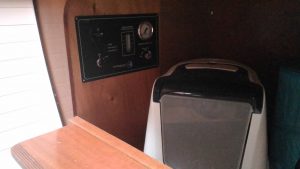
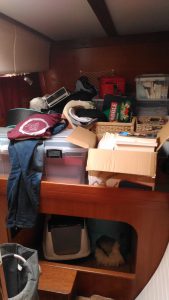
The desalinator sucks up sea water, removes all salt from it turning it into fresh water, and pumps the fresh water into our water bins. The process is pretty seamless, and yet the desalinator makes a lot of noise so we do not keep it on for more than a few hours at a time. We also turn it on in areas where the water is clean. Desalinators remove salt but also all traces of minerals that we get from water and that are necessary for our health, so I may very well be adding trace minerals (thank you long distance running!) to our desalinated water.
The desalinator purifies 50 liters of water per hour. In other words, it would take us 18 hours to fill up our 4 water bins.
Sea Water
To help save fresh water, boats are usually equipped with a sea-water faucet at the kitchen sink, mainly used to do the dishes. Special sea-water soap can be bought in most shipchandlers. The water from this faucet comes directly from the sea via a pedal system that you pump with your foot. In the photos below you can see the sea-water faucet to the left of the sink and the little black pedal at the base of the kitchen counter.
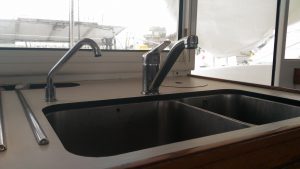
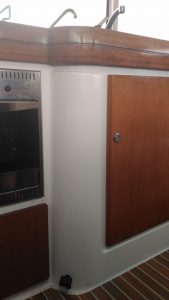
So far we haven’t used the sea water faucet, but we know that the previous owners used it all the time during their transatlantic voyage.
Bottled Water
Last but not least, we tend to bring bottled water aboard. It’s clean, safe, and a good back-up.